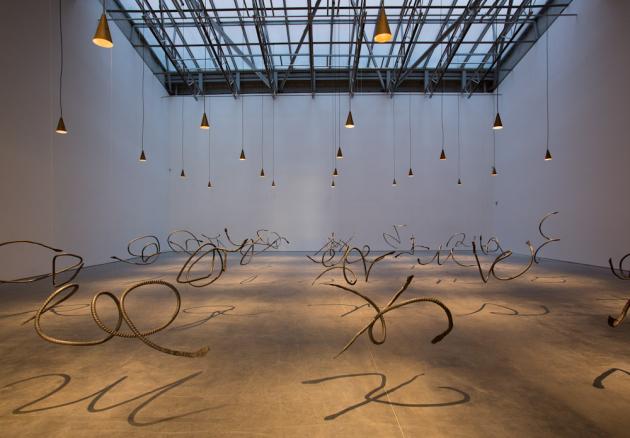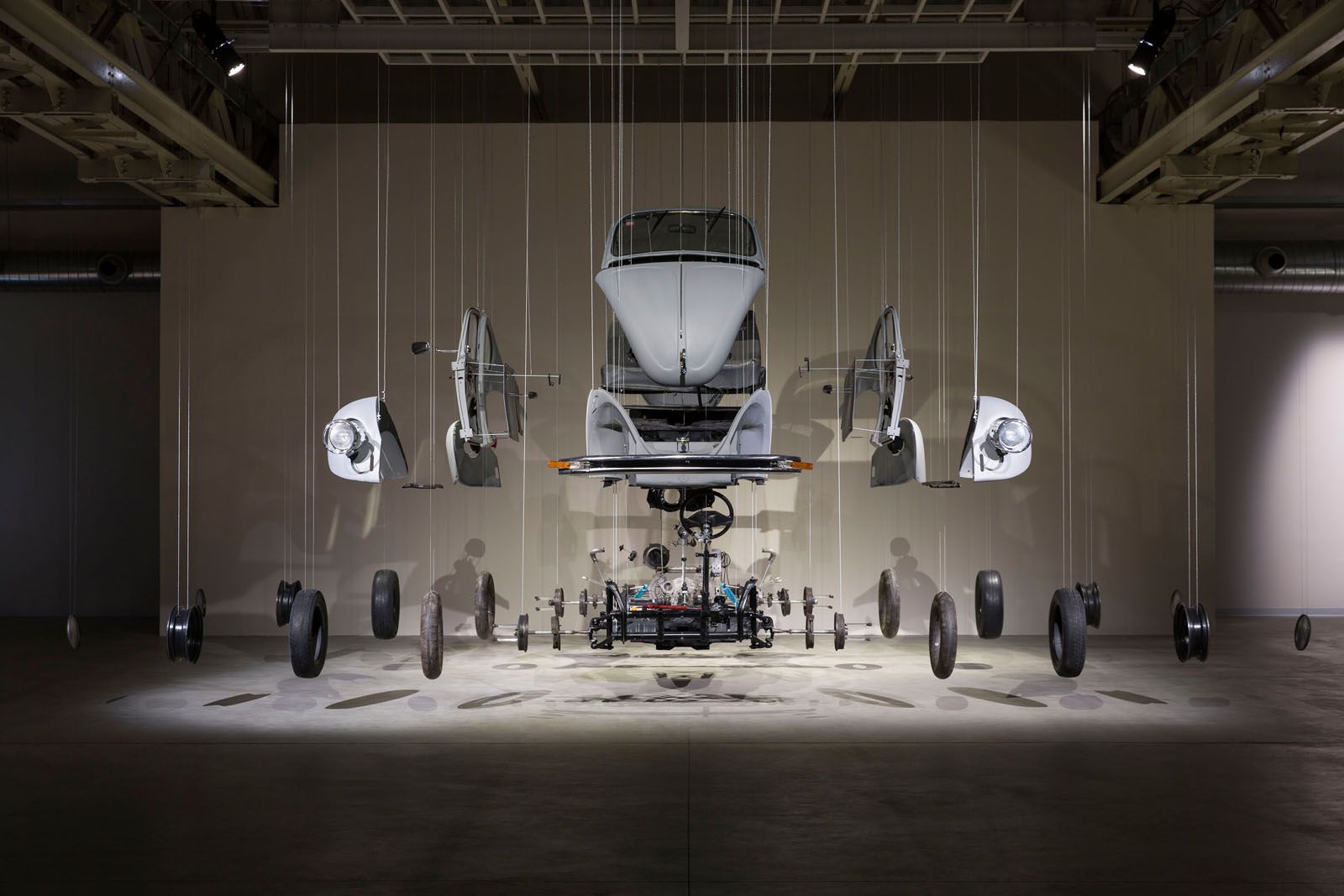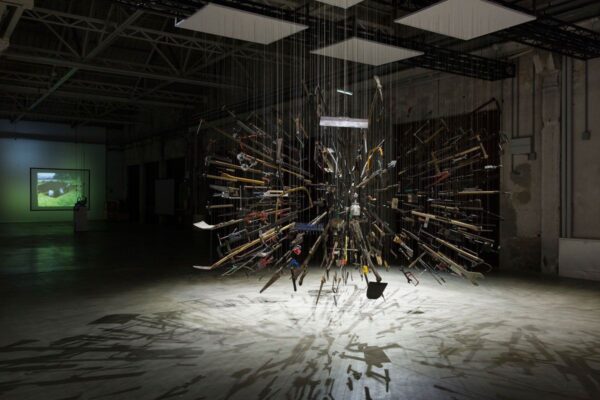
Major retrospective of Damián Ortega, one of the main exponents of contemporary art in Mexico
MARCO in Monterrey presents the largest retrospective of Damián Ortega, one of the main exponents of contemporary art in Mexico
The artist, winner of the prestigious Zurich Art Prize 2023, shows for the first time in Mexico and Latin America his artistic production of more than 30 years of work
Damian Ortega
He is one of the most valued contemporary artists in the art scene in Mexico and Latin America and for the first time he will bring together a great retrospective of 30 years of work in an exhibition in a Latin American country. It is about Damián Ortega, pico y maíz, which delves into the production of this famous Mexican creator, whose work has been exhibited in renowned museums and galleries in Europe and the United States, such as the Tate Modern in London; the Boston Institute of Contemporary Art; or the Botín Center, in Santander, Spain. On this occasion, says the author, he is interested in exposing the production and industrialization processes and also the decline that this industrial work has suffered in the countries that have advanced the most in this form of production.

The retrospective will open to the public at MARCO from August 26 and will be available until February 11. Visitors will be able to appreciate many of the works that have made Ortega famous, who has won the prestigious Zurich Art Prize 2023. Ortega has generated great international interest with many of his works, such as the 'vocho' that he disintegrated piece by piece and suspended from the ceiling, a work that he named cosmic thing and revolutionized the art scene at the Venice Biennale in 2003.
On this occasion, the curatorship was in charge of José Esparza Chong Cuy and from MARCO they explain that the author uses the beak and the corn "as metaphors to address the notions of work, production and industrialization in relation to language, tools and the transformation of matter and energy. For Ortega, the exhibition also intends to discuss the idea of prosperity, the consequences of technical progress, the influence of technology, but also its counterpart, what has to do with organic, food with health.
One of the pieces that are part of the retrospective.MARCO MONTERREY
"What we have is an almost mythical interest in corn," explains the author in an interview via Zoom. “Corn has been seen throughout history as a key element, which even made man, according to the Popol Vuh, which says that the gods created man and woman, it is supposed, from corn. So, the approximations that I have are in many ways that mythology, but it also has a political part that is sovereignty, food, the culture of identity that the corn tortilla has in our country particularly, ”adds Ortega.
---

Ortega's relationship with art began at a very young age. He was a cartoonist and published cartoons in newspapers, but his dream was to become a muralist in a country that has given great names in muralism. Along with other young artists eager to revolutionize art in Mexico, he created spaces to exhibit his work and the Kurimanzutto gallery was born among those spaces, one of the most prestigious on the continent.

“I always liked muralism a lot, because it was a source of interest and complicity since I was little, because I liked to see the walls painted, I liked the story of this character as Orozco, a mythical figure. As a child I was always interested in going to the National Palace or the Fine Arts to see the murals, they were always a benchmark for a world of Mexican artists who had had an international impact. So, like, that image was always there and I started a lot with the idea that I wanted to paint murals,” says Ortega. The artist followed other paths, which have led him to be one of the most internationally valued Mexican creators and as a tribute to that success and recognition, MARCO offers this first major exhibition of 30 years of work, which includes recent and unpublished works. . , like 120 days, ceramics (2020-2023), made up of 120 clay sculptures in the shape of distorted Coca-Cola bottles, and Cadenilla (2014-2023), a textile made in collaboration with an artisan from Oaxaca. "It is a pleasure to work on this project, showing oneself has always been very exciting, because it is also the way of giving and receiving, it is really a dialogue and I am glad that here in Monterrey they have had this initiative, because until now no one had been encouraged to the museum and well, here they have taken a risk”, says Ortega.

- December 14, 2025
Brazilian Artist's Exhibitions at the Vatican

- December 14, 2025
Visual Art in Chile: Memory, Critique, and Experimentation

- December 14, 2025
Visual Art in Bolivia: Ancestry, Resistance, and Identity

- December 14, 2025
Trump's racism

- December 14, 2025
Leopoldo Anjo - Brazil

- December 14, 2025
After Photography by Fred Ritchin

- December 13, 2025
Visual Art in Peru: Ancestral Tradition and Contemporary Creation

- December 13, 2025
Visual Art in Argentina: Identity, Memory, and Experimentation

- December 13, 2025
Art for Gaza

- December 14, 2025
Brazilian Artist's Exhibitions at the V…

- December 13, 2025
Art for Gaza

- December 10, 2025
Pinta Miami 2025 Reaffirms the Strength…

- December 09, 2025
“GENOCIDE” Exhibition and Controversy O…

- December 09, 2025
Indigo Celebrates its 21st Anniversary …

- December 07, 2025
7 Art and Culture Recommendations for T…

- December 07, 2025
Why is Frida Kahlo the woman with the m…

- December 06, 2025
Argentine Art Makes a Grand Entrance at…

- December 06, 2025
Pinta Miami Highlights Sustainable Lati…

- December 04, 2025
Pinta Miami 2025: Epicenter of Contempo…

- December 03, 2025
Pinta Miami Boosts Latin American Art

- December 02, 2025
Exhibition “Unspeakable Gestures,” by A…

- December 02, 2025
Malba: “Pop Brasil” is an essential exh…

- December 01, 2025
Key Fair for Contemporary Latin America…

- December 01, 2025
Unseen Renoir work resurfaces after a c…

- November 30, 2025
How Brazilian Pop Art Challenged the Di…

- November 30, 2025
Palestinian Artist Transforms War Rubbl…

- November 29, 2025
Latin America's Most Important Craft Fa…

- November 29, 2025
Miami, with a Latin rhythm: the region'…

- November 26, 2025
Frida Kahlo Breaks World Auction Record

- October 08, 2023
Illustrations reflect the brutal Israel…

- December 25, 2023
The jury statement of the Iran-Brazil F…

- March 21, 2024
The history of art in Palestine

- July 29, 2023
History of Caricature in Brazil

- September 01, 2023
Neural Filters in new photoshop 2023

- April 20, 2024
Poignant Image of Grief Wins Mohammed S…

- May 22, 2025
Brady Izquierdo’s Personal Exhibition O…

- October 21, 2023
Erick Meyenberg and Tania Ragasol at th…

- June 29, 2024
Exhibition at Centro MariAntonia contra…

- May 15, 2024
Eleven murals for Gaza painted across t…

- February 18, 2024
7 Ways to Understand What Visual Arts A…

- March 14, 2024
museum of statue of van gogh

- May 25, 2025
Bordalo II to hold exhibition in Paris …

- March 15, 2024
museum of sculpture of Salvador Dali

- May 20, 2024
Latin American Festival of Performing A…

- March 30, 2024
illustration websites in Latin America

- August 09, 2023
Venezuela mural expresses solidarity wi…

- July 30, 2024
The artist from San Luis Mirta Celi rep…

- May 27, 2025
Works by Botero, Grau, and 80 other imp…

- January 23, 2025
Art Palm Beach 2025

- May 15, 2024
Eleven murals for Gaza painted across t…

- February 18, 2024
7 Ways to Understand What Visual Arts A…

- January 02, 2025
13 commemorations that will mark the cu…

- October 17, 2023
The influence of Latin American artists…

- February 03, 2024
THE HISTORY OF NAIF ART

- July 02, 2024
One of the largest urban art galleries …

- October 08, 2023
Illustrations reflect the brutal Israel…

- November 17, 2023
Fernando Botero's work is booming after…

- July 29, 2023
Piracicaba International Humor Exhibiti…

- November 06, 2023
Heba Zagout: Palestinian artist murdere…

- December 25, 2023
The jury statement of the Iran-Brazil F…

- December 10, 2023
Sliman Mansour and Palestinian art on t…

- March 14, 2024
museum of statue of van gogh

- February 01, 2025
A maior exposição de Botero em Barcelona

- March 21, 2024
The history of art in Palestine

- July 20, 2024
First International Mail Art Biennial 2…

- April 20, 2024
Poignant Image of Grief Wins Mohammed S…

- October 30, 2023
Palestinian turns images of the Gaza co…

- September 01, 2023
Neural Filters in new photoshop 2023

- February 08, 2024


